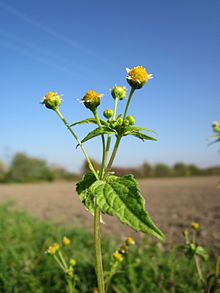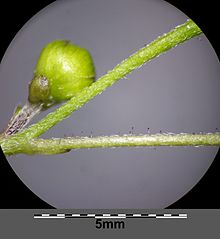Small-flowered button herb
| Small-flowered button herb | ||||||||||||
|---|---|---|---|---|---|---|---|---|---|---|---|---|

Small-flowered button herb |
||||||||||||
| Systematics | ||||||||||||
|
||||||||||||
| Scientific name | ||||||||||||
| Galinsoga parviflora | ||||||||||||
| Cav. |
The Small-flowered button herb or (Hoary) French herb ( Galinsoga parviflora ) is a common weed of the family of the daisy family (Asteraceae).
features
The small-flowered French herb is an annual , herbaceous plant that reaches heights of about 20 centimeters. The stem of the plant is glabrous or hairy only very sparsely. The opposite leaves are undivided and more or less finely serrated at the edge. The flower stalks are hairy a little more densely, but the hairs are close to the stems. In any case, the plant is not shaggy hairy like the hairy button herb .
The flower heads have a diameter of just under 5 mm. The mostly four to five white ray florets are significantly shorter than half the diameter of the yellow head. They are usually a little longer than they are wide and have two or three small teeth in front.
The number of chromosomes is 2n = 16.
ecology
The small-flowered button herb is an annual, summer annual plant and a light and warmth germ. In favorable years, however, it can form two or more generations. As a former tropical plant, it is very sensitive to frost and freezes to death as soon as the first frosts occur. It has roots 25-80 cm deep. It is a light germinator, a cooking indicator and nutrient eater.
The flowers are "cup-shaped flowers", the heads of which ripen one after the other at intervals. There is only self-pollination . Flowering time is from June to October.
The fruits are split fruits, which consist of two small, solitary nuts, and which are firmly connected to the barbed calyx; therefore Velcro spreads. In autumn, parts of stems or entire fruiting plants can also be spread out by animals or as trolleys by the wind. Fruit ripening is from July to September. The seeds can germinate for 1–3 (–8) years.
Occurrence
The small-flowered button herb is a typical " weed ". It likes to grow on fresh to moderately fresh, nutrient-rich, preferably low-lime, humus-rich, loose, sandy loam soils such as in gardens, on fields or on open roadsides. It is widespread and not uncommon, but also not quite as common as the hairy button herb . It occurs in societies of the order Polygono-Chenopodietalia, especially in the Setario-Galinsogetum.
The French herb is a neophyte . The plant originally comes from South America , actually Colombia, where it is very common on the plateau in the village of Guasca (Boyacá), and gives the original name. According to other authors, it originally comes from Mexico. It was planted in botanical gardens at the end of the 18th century , but was soon taken into agricultural culture because of its tasty leaves. Because it spread very quickly and this coincided with the campaigns of Napoleon, the French were wrongly discredited for having brought it in. Today the French herb has spread all over Europe and large parts of Asia . The whole herb is well suited for the preparation of wild herb salad.
use
The French herb can be used as a fodder plant. It provides valuable compost and is therefore suitable for natural fertilization. Young stems and leaves make a vegetable dish when cooked, and a salad when cooked raw. In its actual homeland Colombia it is often used for seasoning and is the characteristic spice ( guasca ) of the chicken soup Ajiaco de Bogotá .
literature
- Henning Haeupler , Thomas Muer: picture atlas of the fern and flowering plants of Germany (= the fern and flowering plants of Germany. Volume 2). Published by the Federal Agency for Nature Conservation. Ulmer, Stuttgart 2000, ISBN 3-8001-3364-4 .
- Wolfgang Adler, Karl Oswald, Raimund Fischer: Excursion flora of Austria. Ed .: Manfred A. Fischer . Ulmer, Stuttgart / Vienna 1994, ISBN 3-8001-3461-6 .
- August Binz , Christian Heitz: School and excursion flora for Switzerland , Schwabe & Co. AG, Basel, 1986, ISBN 3-7965-0832-4
- Erich Oberdorfer : Plant-sociological excursion flora , Ulmer Verlag, Stuttgart, 1990, ISBN 3-8001-3454-3
- Christian August Friedrich Garcke : Illustrierte Flora , 1972, Paul Parey publishing house, ISBN 3-489-68034-0
- Ruprecht Düll , Herfried Kutzelnigg : Pocket dictionary of plants in Germany and neighboring countries. The most common Central European species in portrait. 7th, corrected and enlarged edition. Quelle & Meyer, Wiebelsheim 2011, ISBN 978-3-494-01424-1 .
Individual evidence
- ↑ a b c d Erich Oberdorfer : Plant-sociological excursion flora for Germany and neighboring areas . With the collaboration of Angelika Schwabe and Theo Müller. 8th, heavily revised and expanded edition. Eugen Ulmer, Stuttgart (Hohenheim) 2001, ISBN 3-8001-3131-5 , pp. 930 .
- ^ Galinsoga in the Germplasm Resources Information Network (GRIN), USDA , ARS , National Genetic Resources Program. National Germplasm Resources Laboratory, Beltsville, Maryland. Retrieved March 14, 2018.
Web links
- Small-flowered button herb. In: FloraWeb.de.
- Small-flowered button herb . In: BiolFlor, the database of biological-ecological characteristics of the flora of Germany.
- Profile and distribution map for Bavaria . In: Botanical Information Hub of Bavaria .
- Galinsoga parviflora Cav. In: Info Flora , the national data and information center for Swiss flora . Retrieved May 3, 2016.
- Distribution in the northern hemisphere according to Hultén
- Thomas Meyer: Button herb data sheet with identification key and photos at Flora-de: Flora von Deutschland (old name of the website: Flowers in Swabia )




